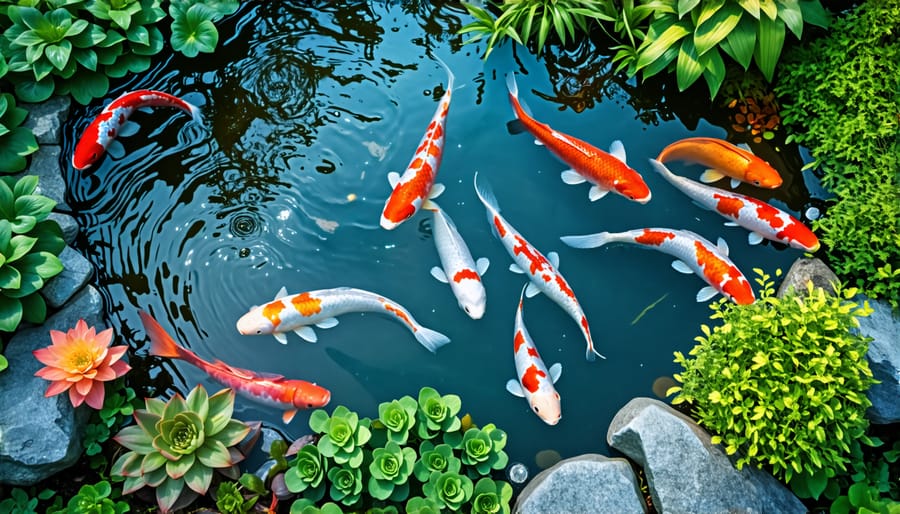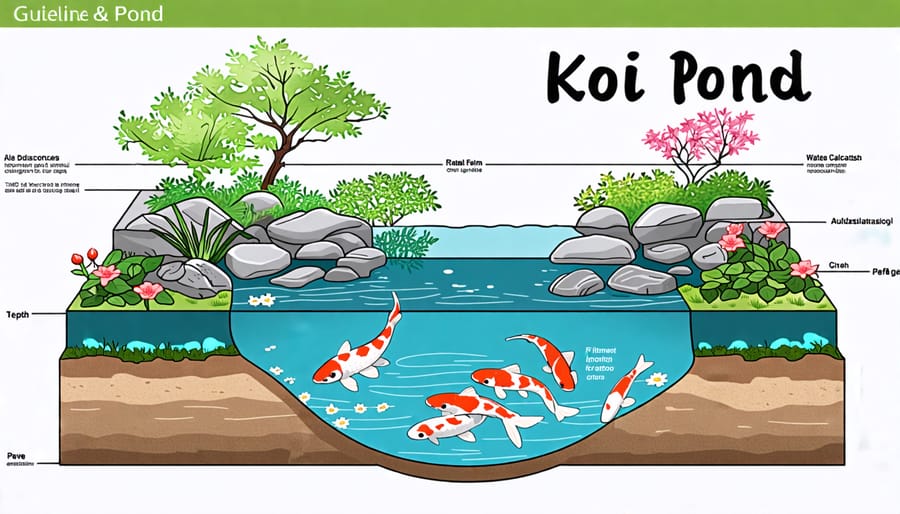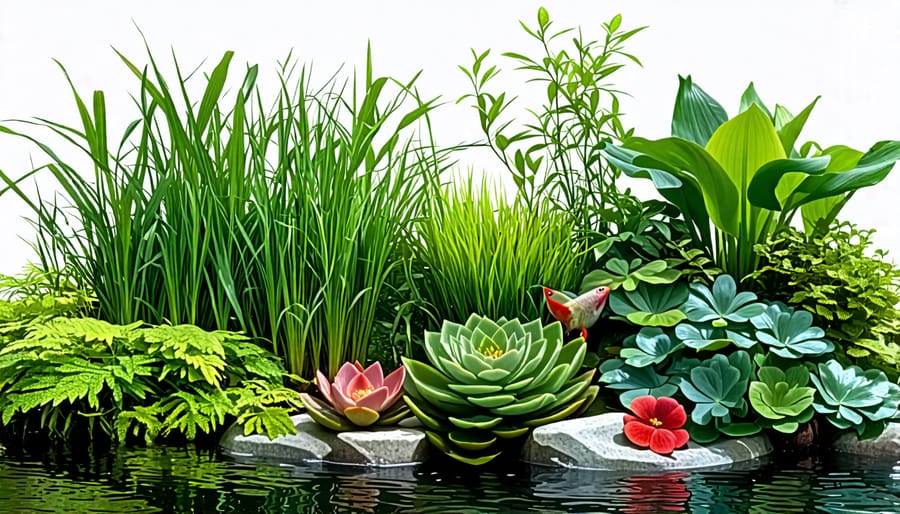
6 Steps to Creating a Thriving Koi Pond Ecosystem
Dive into the tranquil world of koi pond ecosystems – a harmonious dance of water, fish, and plants. Crafting a thriving koi habitat requires a delicate balance of key elements. From thoughtful pond design that mimics natural environments to meticulous water quality management, each aspect plays a vital role. Discover the art of selecting compatible koi varieties and integrating aquatic plants that provide both beauty and biological filtration. Explore the seasonal rhythms of koi care, from spring awakenings to winter preparations. Immerse yourself in the fascinating journey of cultivating a captivating, self-sustaining underwater oasis that enchants the senses and soothes the soul.
Designing Your Koi Pond

Size and Depth
For a thriving koi pond ecosystem, size and depth matter. As a general rule, plan for at least 1,000 gallons of water per adult koi. This translates to a minimum pond size of 8 feet by 6 feet with an average depth of 3 feet. However, in regions with harsh winters, a depth of at least 4 feet is crucial for overwintering. This extra depth provides a stable temperature zone at the bottom where koi can hibernate safely. Additionally, a larger volume of water maintains a more consistent temperature and water chemistry, reducing stress on your fish. When designing your pond, create various depth zones to accommodate different plants and provide koi with areas for feeding, swimming, and resting. A well-planned pond size and depth lay the foundation for a robust ecosystem where your koi can thrive year-round.
Circulation and Filtration
Proper circulation and filtration are crucial for maintaining a healthy koi pond ecosystem. Water flow helps distribute oxygen, prevents stagnation, and removes waste products. Pond filters, such as mechanical and biological filters, work to remove debris and harmful toxins from the water. A well-designed filtration system, combined with natural filtration methods like plants and beneficial bacteria, helps keep the water crystal clear and safe for your koi. Regularly cleaning and maintaining your filters ensures they function optimally. Consider adding waterfalls, fountains, or streams to enhance circulation and aeration. By prioritizing circulation and filtration, you create a stable environment that promotes the health and well-being of your koi while maintaining the aesthetic appeal of your pond.
Koi Pond Landscaping
Landscaping around your koi pond creates a serene, natural setting. Incorporate a variety of aquatic plants like water lilies, lotus, and marginal plants to provide shade, filtration, and visual interest. Use rocks and boulders to define the pond’s edge, create waterfalls, and provide hiding spots for your fish. Integrate the pond into your surrounding landscape with complementary terrestrial plants, pathways, and seating areas. Consider the mature size of plants and ensure adequate space for growth. Avoid invasive species that can overtake the ecosystem. With thoughtful design, your koi pond will become a beautiful, tranquil oasis in your outdoor space.
Water Quality Essentials
Nitrogen Cycle
The nitrogen cycle is a crucial process in maintaining a balanced koi pond ecosystem. It involves the conversion of toxic ammonia, produced by fish waste and decaying organic matter, into less harmful substances. Beneficial bacteria, such as Nitrosomonas and Nitrobacter, play a key role in this process. Nitrosomonas converts ammonia into nitrite, which is then transformed into nitrate by Nitrobacter. Nitrate, in low levels, is relatively harmless to fish and serves as a nutrient for aquatic plants. These plants absorb nitrate, helping to keep the water clean and clear. To support a healthy nitrogen cycle, it’s essential to establish a balance between fish, bacteria, and plants in your koi pond. Regular water testing, proper filtration, and avoiding overfeeding can help maintain this delicate balance. Patience is key, as it takes time for the nitrogen cycle to establish itself in a new pond.

Testing and Adjusting Water
Regular testing is essential to maintain optimal water quality in your koi pond. Invest in a reliable test kit to monitor pH, ammonia, nitrite, and nitrate levels weekly. Aim for a stable pH between 7.0-8.0. If levels are off, make gradual adjustments using pH modifiers. Ammonia and nitrite should remain at 0 ppm, while nitrate should stay below 50 ppm. Perform partial water changes of 10-15% every other week to refresh the ecosystem. Keep a log to track trends and address issues promptly. With consistent monitoring, you’ll create a thriving environment for your koi to flourish.
Stocking Your Koi Pond
Choosing Healthy Koi
When selecting koi for your pond, look for fish that are active, have clear eyes, and display vibrant colors. Avoid any koi with visible wounds, fin damage, or signs of disease. It’s best to purchase from a reputable dealer who can provide health guarantees and a diverse gene pool.
Before introducing new koi to your pond, it’s crucial to quarantine them for at least 2-4 weeks in a separate tank. This allows you to monitor their health, treat any potential issues, and prevent the spread of diseases to your existing fish. During quarantine, maintain optimal water conditions and gradually acclimate the koi to the pond’s temperature and chemistry.
Proper quarantine procedures and careful selection of healthy koi are essential steps in maintaining a thriving pond ecosystem. By taking the time to choose robust fish and ensuring their smooth transition, you’ll be setting your koi pond up for long-term success and enjoyment.
Koi Companions
Koi ponds can be home to more than just colorful koi. Several other fish species, such as goldfish, golden orfe, and mosquitofish, make excellent companions for koi. These fish help maintain the pond’s ecosystem by consuming algae and mosquito larvae. Invertebrates like snails, freshwater shrimp, and mussels also play a vital role in keeping the water clean and balanced. They feed on debris and excess algae, acting as natural filtration systems. Additionally, wildlife such as frogs, dragonflies, and birds are attracted to the pond, contributing to its biodiversity. Frogs and dragonflies prey on insects, while birds may occasionally visit for a drink or quick bath. When selecting companions for your koi, ensure they are compatible in terms of size, temperament, and environmental requirements. Proper research and planning will help you create a thriving, diverse ecosystem where koi and their companions can coexist harmoniously.
Balancing with Aquatic Plants

Oxygenators and Floaters
Oxygenating plants like hornwort, anacharis, and cabomba help maintain healthy dissolved oxygen levels in your koi pond. These submerged plants absorb carbon dioxide and release oxygen through photosynthesis, creating a balanced environment for your fish. Floating plants such as water lettuce and water hyacinth provide shade, reducing algae growth and keeping water temperatures stable. Their extensive root systems also absorb excess nutrients, helping to purify the water. Lilies and lotuses, with their broad leaves, offer additional shade and add a beautiful, serene touch to your pond’s surface. Incorporate a variety of oxygenators and floaters to create a diverse, self-sustaining ecosystem that benefits your koi and enhances the overall aesthetic of your backyard oasis. Experiment with different combinations to find the perfect balance for your specific pond conditions and enjoy the tranquility and beauty these plants bring to your water garden.
Marginal and Bog Plants
Marginal and bog plants play a crucial role in maintaining the health and clarity of your koi pond ecosystem. These plants thrive in the shallow edges of the pond, with their roots submerged in the water. Popular marginal plants include cattails, rushes, and irises, which not only add visual interest but also help filter the water. Bog plants like water lilies and lotus provide shade and shelter for your koi while absorbing excess nutrients. As these plants grow, they remove nitrates and other harmful substances from the water, acting as a natural filtration system. When selecting marginal and bog plants, consider their mature size and growth habits to ensure they won’t overcrowd your pond. Planting them in aquatic baskets or fabric planters filled with a clay-based soil mix allows for easy management and containment. Regular pruning and division of these plants will keep them healthy and maintain the ecological balance of your koi pond.
Seasonal Pond Maintenance
Spring and Summer Care
As spring and summer arrive, your koi pond will burst with life. To maintain a healthy ecosystem, trim back any overgrown plants and remove debris from the pond surface. Adjust your fish feeding schedule as water temperatures rise, providing smaller, more frequent meals. Monitor water quality closely, as warmer conditions can lead to algae blooms. Employ a combination of physical removal, external filters, and beneficial bacteria to keep algae under control. Regularly test pH, ammonia, and nitrite levels, making adjustments as needed. Prune and fertilize aquatic plants to promote lush growth, which helps absorb excess nutrients and provide shade for your koi. By staying proactive with plant maintenance, feeding adjustments, and algae control, you’ll ensure your koi pond ecosystem thrives throughout the warm season, creating a beautiful and balanced oasis in your backyard.
Fall and Winter Preparation
As temperatures drop in fall and winter, it’s important to prepare your koi pond for the colder months. Start by gradually reducing feeding and eventually stopping when water temperatures dip below 50°F, as koi become less active. Remove any debris from the pond and trim back dying plant foliage. Install pond netting to catch falling leaves and prevent predators from targeting vulnerable fish. In colder climates, you may need to shut down pumps and filters to prevent damage from freezing. Ensure your koi have a deep enough section of the pond to overwinter comfortably, as they will enter a dormant state until spring.
Conclusion
Creating a thriving koi pond ecosystem is a rewarding experience that brings beauty and tranquility to your outdoor space. By understanding the delicate balance between water quality, fish health, and plant life, you can establish a self-sustaining environment that supports the well-being of your koi. With the knowledge gained from this article, you now have the tools to design, build, and maintain a stunning koi pond that will be the centerpiece of your garden. Remember to regularly monitor water parameters, provide proper nutrition for your fish, and incorporate the right plants to maintain a healthy ecosystem. As you embark on this exciting journey, enjoy the process of creating a living work of art that will bring you joy for years to come. Happy pond building!
